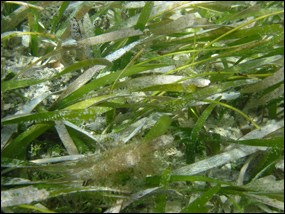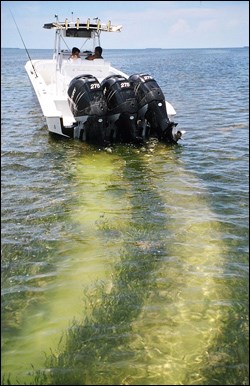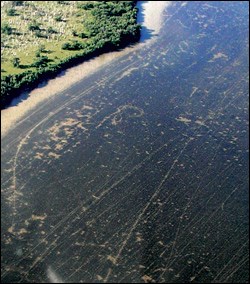
Original artwork courtesy of Kathleen Konicek-Moran, NPS volunteer 
NPS photo Florida Bay is characterized by extensive areas of shallow water. Banks separate the bay into a mosaic of deeper natural basins that are interconnected by natural and man-made channels through the banks. Much of the bay bottom supports submerged aquatic vegetation consisting of seagrasses and marine algae of various species. These vegetated areas serve as nursery habitat for commercially important fisheries, such as spiny lobster, stone crab, pink shrimp, and a variety of reef fish species. The bay and its submerged vegetation also provide habitat and feeding grounds for state and federally listed species such as manatees, smalltooth swordfish, and sea turtles. Recreationally important fish species in Florida Bay include bonefish, spotted seatrout, gray snapper, snook, redfish, and tarpon. Seagrasses 
NPS photo Seagrasses are grass-like flowering plants that live completely submerged in marine and estuarine waters. Because most species require high levels of light, the depth at which seagrasses occur is limited by water clarity. In addition to providing food and shelter for many species of marine wildlife, seagrasses provide a variety of ecosystem services: processes by which the environment produces resources that humans often take for granted, such as clean water. Seagrasses help maintain water quality by trapping fine sediments and particles with their leaves and stabilize the sea bottom with their roots and rhizomes. Even after seagrass dies, the detritus formed by the microbial breakdown of its leaves and roots is an important food source for many species, including scavengers. 
NPS photo Increased boating activity, often by boaters with limited or no previous experience in navigating the numerous shallow flats and complex of narrow channels in Florida Bay, makes parts of the bay susceptible to visitor impacts resulting from the operation of motorized watercraft. Damage from boats generally occurs when a boat propeller contacts either the submerged vegetation or the vegetation and the bay bottom. In addition to uprooting and destroying vegetation, sediment excavated by boat propellers can settle into berms alongside the scars, burying seagrasses and causing mortality of flora and fauna. 
NPS photo by Lori Oberhofer The bottom of Florida Bay is legally designated as submerged wilderness as part of the Marjory Stoneman Douglas Wilderness and is thereby protected by the Wilderness Act of 1964. Propeller scars lead to loss of wilderness resources and seagrass biomass and, in more severe incidents, to long-term damage to seagrass beds. Structural changes in seagrass communities from propeller scarring include physical destruction of the seagrasses, increased sediment resuspension, and a potential increase in the susceptibility of seagrass beds to damage from hurricanes. Propeller scarring has been observed throughout Florida Bay in shallow flats, bights, bays, and banks and in other high-use areas. Restoration of damaged seagrass communities is technically possible, but expensive and time consuming. About the Illustrations The vibrant, detailed botanical illustrations on this page and others are by NPS volunteer and artist Kathleen Konicek-Moran. Kathleen has graciously allowed Everglades National Park to use her original works to help convey the vital connections inherent within the Everglades ecosystem. Learn more about Kathleen Konicek-Moran and what inspires her bountiful flow of creativity. |
Last updated: June 1, 2021
